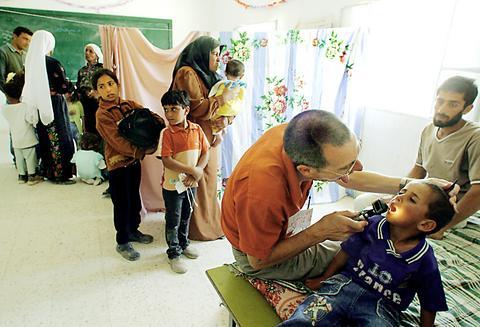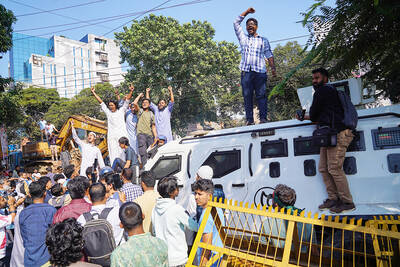It was a routine examination, a lanky doctor checking a frightened boy's chest with a stethoscope, then showing him how to use an inhaler for the wheezing he suffers when playing too hard.
But the doctor was Israeli, the boy Palestinian and the exam took place in a dusty West Bank hill town in a schoolhouse converted for the day into a makeshift clinic.
A group of 650 Israeli doctors has been sending a contingent once a week to various places in the West Bank and Gaza to offer health care. The doctors say they want to show a gentler face of Israeli society after the violence of the last three years.

PHOTO: NY TIMES
Khalid Moussa, a villager who visited the clinic to have his son's eyes checked, said the doctors' visits were a needed overture that he hoped would teach Israelis about Palestinian culture.
"If you antagonize me, I fight back," he said. "If you respect me and honor my existence, I'm willing to give you my last piece of bread to show you the same attitude."
The visits are also an example of the efforts by people on both sides of the conflict to keep up a conversation even as civilians and fighters on both sides are killed. Israeli and Palestinian families who have lost children in the conflict meet to share their grief and press for peace, and there are organized dialogues for teenagers.
Recently, residents of Mevasseret Zion, a Jerusalem suburb, and Beit Sourik, an adjacent Palestinian village, flew kites as a demonstration of the neighborly relations they say will be damaged by the barrier that Israel is building between them.
The doctors are members of Physicians for Human Rights, an organization started in 1983 that dissents from many Israeli policies and says Israel could do more to achieve a peace accord.
Although they regard the Palestinian doctors with respect, the
Israeli doctors also know that there are too few specialists in the West Bank and that the poor often find it hard to get to doctors and hospitals because of the Israeli checkpoints set up to curb militants' attacks.
The group offers its services free, and even some of the doctors taking part concede that their work here is more a gesture than anything else.
Dr. Dani Schurr, a 55-year-old pediatrician who normally works in a Jerusalem clinic, said he came out several times a year.
"I want to be able to say that in this time I didn't just read the newspapers, but I went through the barricades and I worked with the people," he said. "It's a way to show another face of an Israeli."
On a recent day, eight doctors and four paramedics left Jerusalem in four vans and traveled 45 minutes into West Bank territory near Hebron before they veered onto a dirt road up to this farming village of stone and mud hovels.
Two hundred villagers awaited them in a rough-and-tumble line along a schoolhouse terrace, mostly women in long dresses and head scarves carrying small children.
Schurr examined more than 30 children. There was a three-year-old with a cleft palate, a toddler with a parasite brought on by eating unwashed vegetables and a 10-month-old girl with fever and diarrhea.
Dr. Abdel Rahim Johshan, a Palestinian, joined him for a consultation on eight-year old Hamad Ranim Aburam, a pale and slender, wheezing boy. Schurr offered a diagnosis of exercise-induced asthma and had a medical assistant bring in an inhaler.
"Lots of kids, as they grow up, the symptoms disappear," he assured Hamad's mother.
A local Palestinian Authority official, who helped arrange the visit but did not want to be identified, "The main reason we do this is the message of cooperation, the message that we can live with each other."

DISASTER: The Bangladesh Meteorological Department recorded a magnitude 5.7 and tremors reached as far as Kolkata, India, more than 300km away from the epicenter A powerful earthquake struck Bangladesh yesterday outside the crowded capital, Dhaka, killing at least five people and injuring about a hundred, the government said. The magnitude 5.5 quake struck at 10:38am near Narsingdi, Bangladesh, about 33km from Dhaka, the US Geological Survey (USGS) said. The earthquake sparked fear and chaos with many in the Muslim-majority nation of 170 million people at home on their day off. AFP reporters in Dhaka said they saw people weeping in the streets while others appeared shocked. Bangladesh Interim Leader Muhammad Yunus expressed his “deep shock and sorrow over the news of casualties in various districts.” At least five people,

LEFT AND RIGHT: Battling anti-incumbent, anticommunist sentiment, Jeanette Jara had a precarious lead over far-right Jose Antonio Kast as they look to the Dec. 14 run Leftist candidate Jeannette Jara and far-right leader Jose Antonio Kast are to go head-to-head in Chile’s presidential runoff after topping Sunday’s first round of voting in an election dominated by fears of violent crime. With 99 percent of the results counted, Jara, a 51-year-old communist running on behalf of an eight-party coalition, won 26.85 percent, compared with 23.93 percent for Kast, the Servel electoral service said. The election was dominated by deep concern over a surge in murders, kidnappings and extortion widely blamed on foreign crime gangs. Kast, 59, has vowed to build walls, fences and trenches along Chile’s border with Bolivia to

DEATH SENTENCE: The ousted leader said she was willing to attend a fresh trial outside Bangladesh where the ruling would not be a ‘foregone conclusion’ Bangladesh’s fugitive former prime minister Sheikh Hasina yesterday called the guilty verdict and death sentence in her crimes against humanity trial “biased and politically motivated.” Hasina, 78, defied court orders that she return from India to attend her trial about whether she ordered a deadly crackdown against the student-led uprising that ousted her. She was found guilty and sentenced to death earlier yesterday. “The verdicts announced against me have been made by a rigged tribunal established and presided over by an unelected government with no democratic mandate,” Hasina said in a statement issued from hiding in India. “They are biased and politically motivated,” she

It is one of the world’s most famous unsolved codes whose answer could sell for a fortune — but two US friends say they have already found the secret hidden by Kryptos. The S-shaped copper sculpture has baffled cryptography enthusiasts since its 1990 installation on the grounds of the CIA headquarters in Virginia, with three of its four messages deciphered so far. Yet K4, the final passage, has kept codebreakers scratching their heads. Sculptor Jim Sanborn, 80, has been so overwhelmed by guesses that he started charging US$50 for each response. Sanborn in August announced he would auction the 97-character solution to K4